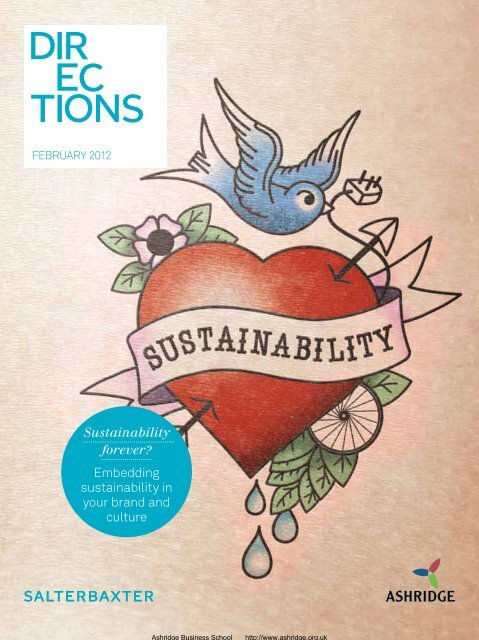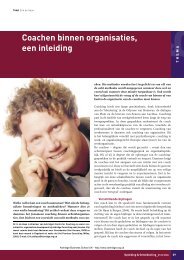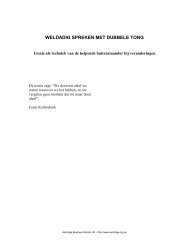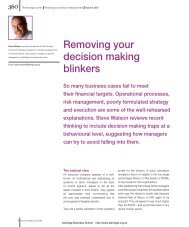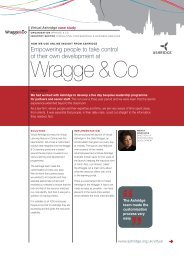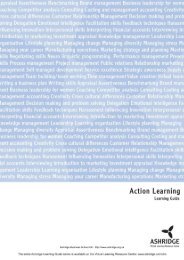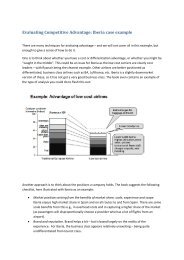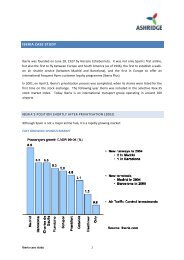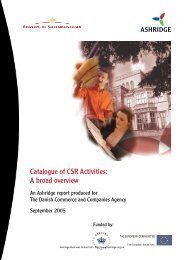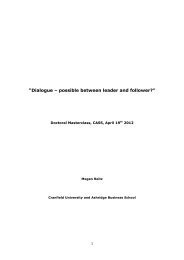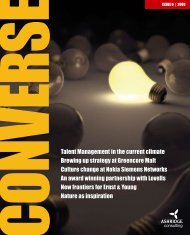Sustainability Forever? Embedding sustainability in your ... - Ashridge
Sustainability Forever? Embedding sustainability in your ... - Ashridge
Sustainability Forever? Embedding sustainability in your ... - Ashridge
Create successful ePaper yourself
Turn your PDF publications into a flip-book with our unique Google optimized e-Paper software.
FEBRUARY 2012<br />
<strong>Susta<strong>in</strong>ability</strong><br />
forever?<br />
<strong>Embedd<strong>in</strong>g</strong><br />
<strong>susta<strong>in</strong>ability</strong> <strong>in</strong><br />
<strong>your</strong> brand and<br />
culture<br />
<strong>Ashridge</strong> Bus<strong>in</strong>ess School http://www.ashridge.org.uk
IntRodUctIon<br />
If the company you work for was to have a tattoo, what would it say?<br />
Perhaps not a usual question, but worth consider<strong>in</strong>g for a moment –<br />
a tattoo is, after all, an expression of a person’s identity.<br />
Recent research by <strong>Ashridge</strong> Bus<strong>in</strong>ess School has found that<br />
successful change strategies for <strong>susta<strong>in</strong>ability</strong> need to take<br />
<strong>in</strong>to account an organisation’s identity. true <strong>susta<strong>in</strong>ability</strong><br />
is a product of a company’s culture, and evolves from it,<br />
as well as develop<strong>in</strong>g the culture <strong>in</strong> new directions. the first<br />
article <strong>in</strong>troduces the ‘talik’, the model of change developed<br />
by <strong>Ashridge</strong>.<br />
SUStAInABILItY AS USUAL<br />
1 DIRECTIONS FEBRUARY 2012 SAlTERBAxTER<br />
In the second article, Luc<strong>in</strong>da Hensman of coca-cola<br />
Enterprises discusses the evolution of their new <strong>susta<strong>in</strong>ability</strong><br />
plan <strong>in</strong> relationship to the talik – a plan which both reflects<br />
the company culture and stretches it. Is <strong>your</strong> company ready<br />
to commit to <strong>susta<strong>in</strong>ability</strong> forever – or where are you on the<br />
journey? We’d love to hear <strong>your</strong> thoughts and experiences on<br />
the subject.<br />
Alexandra Stubb<strong>in</strong>gs and Nicolas Ceasar, Co-heads of the <strong>Susta<strong>in</strong>ability</strong><br />
Practice at <strong>Ashridge</strong> Bus<strong>in</strong>ess School, <strong>in</strong>troduce a major new piece<br />
of research on how organisations are embedd<strong>in</strong>g <strong>susta<strong>in</strong>ability</strong>.<br />
Strategic alignment for embedd<strong>in</strong>g <strong>susta<strong>in</strong>ability</strong><br />
When it comes to change strategies for embedd<strong>in</strong>g<br />
<strong>susta<strong>in</strong>ability</strong>, hav<strong>in</strong>g a powerful brand is both a bless<strong>in</strong>g<br />
and a curse. Instantly recognisable, coca-cola, Virg<strong>in</strong> or Apple<br />
evoke an immediate cluster of associations, and depend<strong>in</strong>g<br />
on whether you’re a customer, activist or <strong>in</strong>vestor those<br />
associations may have halos, horns or otherwise. Hav<strong>in</strong>g a<br />
strong brand can confer a social licence to push boundaries<br />
on behalf of <strong>your</strong> stakeholders; but it can also limit the<br />
freedom to experiment and <strong>in</strong>novate.<br />
the importance of external brand to <strong>susta<strong>in</strong>ability</strong> is well<br />
recognised. But what about <strong>in</strong>ternally? What’s the relationship<br />
between <strong>susta<strong>in</strong>ability</strong>, brand and culture? If culture is<br />
‘the way we do th<strong>in</strong>gs around here’ then arguably it needs<br />
to reflect the values and pr<strong>in</strong>ciples our brands espouse. In our<br />
<strong>in</strong>creas<strong>in</strong>gly boundaryless and hyper-connected world, where<br />
any discrepancy between <strong>in</strong>tention and action can produce<br />
immediate accusations of greenwash across the twittersphere,<br />
alignment between brand and culture – the talk and the<br />
walk – is ever more vital. Unfortunately the fault-l<strong>in</strong>es between<br />
them can be considerable and this is often where change<br />
strategies come unstuck.<br />
over the past year, <strong>Ashridge</strong> has conducted a major piece of<br />
research, review<strong>in</strong>g 176 <strong>susta<strong>in</strong>ability</strong> reports and <strong>in</strong>terview<strong>in</strong>g<br />
practitioners from across 24 organisations who are lead<strong>in</strong>g<br />
<strong>Ashridge</strong> Bus<strong>in</strong>ess School http://www.ashridge.org.uk<br />
Olivia SPr<strong>in</strong>kel<br />
Senior <strong>Susta<strong>in</strong>ability</strong><br />
Consultant, Salterbaxter<br />
on embedd<strong>in</strong>g <strong>susta<strong>in</strong>ability</strong>. We asked them for their stories<br />
of success and the role of culture <strong>in</strong> enabl<strong>in</strong>g and <strong>in</strong>hibit<strong>in</strong>g<br />
change. As you would imag<strong>in</strong>e we heard a lot of <strong>in</strong>spir<strong>in</strong>g<br />
examples. But what differentiated the real pioneers was<br />
the <strong>in</strong>tersection of brand, culture and how they are fram<strong>in</strong>g<br />
<strong>susta<strong>in</strong>ability</strong>. Most significantly, the change strategies they<br />
employed took account (consciously or otherwise) of their<br />
organisation’s identity.<br />
In organisational change circles, ‘identity’ has historically<br />
been a poor cous<strong>in</strong> to culture. It’s more readily associated with<br />
market<strong>in</strong>g and image, but it is clearly much wider than that.<br />
organisational identity is a psychological phenomenon, as<br />
much about the unconscious and taken for granted sense<br />
of ‘who we are together’ as it is about the image we want<br />
to portray. organisational identity is where brand and culture<br />
meet. We express who we are – our values, culture, our<br />
strategic <strong>in</strong>tent – through the labels we use to describe<br />
ourselves. We create impressions to the market through our<br />
products and services, our market<strong>in</strong>g and communications<br />
strategies. External stakeholders make sense of those<br />
messages and reflect back a revised image which is then made<br />
sense of <strong>in</strong>ternally and becomes embedded <strong>in</strong>to the culture.<br />
Like two <strong>in</strong>teract<strong>in</strong>g feedback loops – one more externally<br />
focused, the other <strong>in</strong>ternally – this process of mean<strong>in</strong>g mak<strong>in</strong>g<br />
goes on all the time, whether we notice it or not.
How is this useful for embedd<strong>in</strong>g <strong>susta<strong>in</strong>ability</strong>?<br />
Firstly, <strong>susta<strong>in</strong>ability</strong> is still a contested and ill-def<strong>in</strong>ed concept.<br />
one organisation will frame the term us<strong>in</strong>g language borrowed<br />
from Quality and Lean processes (efficiency, waste reduction);<br />
another will borrow from risk management (mitigation, control,<br />
resilience). depend<strong>in</strong>g on the dom<strong>in</strong>ant identity labels, some<br />
frames will resonate and get traction faster than others. For<br />
Virg<strong>in</strong>, the challenger brand identity is a compell<strong>in</strong>g one, and<br />
fram<strong>in</strong>g <strong>susta<strong>in</strong>ability</strong> as ground break<strong>in</strong>g <strong>in</strong>novation, beat<strong>in</strong>g<br />
the competition, as adventure, reflects well the image staff have<br />
of their company. For coca-cola Enterprises, the youthful,<br />
fresh lifestyle identity will connect more readily with Gen Y and<br />
their desire for greater mean<strong>in</strong>g and freedom <strong>in</strong> their work.<br />
connect<strong>in</strong>g with stakeholders and employees through these<br />
common identity labels generates positivity and goodwill,<br />
enabl<strong>in</strong>g more stretch<strong>in</strong>g change strategies that have a greater<br />
chance of traction.<br />
Secondly, address<strong>in</strong>g the complex contextual issues that get<br />
bracketed as <strong>susta<strong>in</strong>ability</strong> – material resource depletion,<br />
environmental degradation, social unrest, economic imbalance<br />
and so on – br<strong>in</strong>gs to the fore the deep-set values and beliefs<br />
from which our identities derive. this is more than a question<br />
of <strong>in</strong>dividual status (though that’s a considerable concern <strong>in</strong><br />
itself). It’s about our collective self-worth. People don’t want<br />
to be villa<strong>in</strong>ised for their organisation’s corporate responsibility<br />
or environmental record. (How does it feel to be a BP employee<br />
right now?) We want to feel like the good guys and focus<strong>in</strong>g on<br />
a positive environmental and social agenda builds positive<br />
personal and group ‘affect’. Unilever are see<strong>in</strong>g the benefit<br />
of this already <strong>in</strong> their employee engagement scores. When<br />
<strong>in</strong>terviewed, they expla<strong>in</strong>ed how the publication of their<br />
Susta<strong>in</strong>able Liv<strong>in</strong>g Plan, and the whole organisation programme<br />
of change to deliver it, has boosted scores by double digit<br />
percentage po<strong>in</strong>ts. More engaged employees equals higher<br />
performance and top-l<strong>in</strong>e revenues, and all this whilst<br />
decoupl<strong>in</strong>g growth from environmental impact.<br />
<strong>Ashridge</strong> Bus<strong>in</strong>ess School http://www.ashridge.org.uk<br />
Identity then is a central concern <strong>in</strong> the development of a strategy<br />
for embedd<strong>in</strong>g <strong>susta<strong>in</strong>ability</strong>. there were other ‘concerns’<br />
too, specific to the <strong>susta<strong>in</strong>ability</strong> agenda, such as design<strong>in</strong>g<br />
values-led <strong>in</strong>novation strategies, lead<strong>in</strong>g jo<strong>in</strong>ed-up technical<br />
and cultural change. the practitioners we spoke to are highly<br />
skilled and they’d learnt as they went along without a bluepr<strong>in</strong>t<br />
or roadmap. draw<strong>in</strong>g on their examples, and from our own<br />
experience, we put together an <strong>in</strong>tegrated model of change<br />
that starts to address the dist<strong>in</strong>ctive concerns of <strong>susta<strong>in</strong>ability</strong>.<br />
The talik: a model of change for the era of <strong>susta<strong>in</strong>ability</strong><br />
the ‘talik’ (named after naturally occurr<strong>in</strong>g positive feedback<br />
loop that keeps water liquid <strong>in</strong> the frozen tundra) is a model<br />
and theory of change <strong>in</strong>tended to take account of:<br />
• the need for strategic alignment across a number of<br />
(potentially compet<strong>in</strong>g) <strong>in</strong>ternal and external stakeholder<br />
agendas<br />
• the need for high <strong>in</strong>clusion based organisational change<br />
processes that work with culture and identity (behaviour<br />
and values) as well as technical and structural change<br />
• the natural cycles of learn<strong>in</strong>g and adaptation that occur<br />
as an organisation responds to its context<br />
• the different start<strong>in</strong>g po<strong>in</strong>ts required by particular cultural<br />
conditions (plac<strong>in</strong>g emphasis on one or another dimension)<br />
• the importance of coherence and consistency throughout<br />
the change process<br />
• the central role of sense-mak<strong>in</strong>g or mean<strong>in</strong>g-mak<strong>in</strong>g <strong>in</strong> br<strong>in</strong>g<strong>in</strong>g<br />
together these <strong>in</strong>ternal and external organisational aspects<br />
Each of the organisations <strong>in</strong>terviewed showed a preference<br />
for one or another of the four ‘E’s’ and a way of fram<strong>in</strong>g<br />
<strong>susta<strong>in</strong>ability</strong> from that angle. Some of the most progressive<br />
examples, such as Marks & Spencer’s Plan A and Unilever’s<br />
Susta<strong>in</strong>able Liv<strong>in</strong>g Plan <strong>in</strong>tegrate them all. Each stage raises<br />
questions about who needs to be <strong>in</strong>volved and what factors to<br />
address. In most circumstances engag<strong>in</strong>g is the obvious place<br />
to start. But as an illustration, we can use Vodafone’s story<br />
of M-Pesa, the mobile payments platform launched <strong>in</strong> Kenya;<br />
a great example of an organisation work<strong>in</strong>g <strong>in</strong>tuitively around<br />
the talik. In this <strong>in</strong>stance we start the story with ‘express<strong>in</strong>g’ –<br />
the decision to launch a new service.<br />
Express<strong>in</strong>g<br />
Initially a match-funded <strong>in</strong>itiative with department for Internal<br />
development (dfId), M-Pesa (Pesa is Swahili for money)<br />
was born out of the <strong>Susta<strong>in</strong>ability</strong> function. the service and<br />
<strong>in</strong>frastructure was developed with partners on the ground. the<br />
offer reflected the values of Vodafone and although it was a<br />
project marg<strong>in</strong>al to the ma<strong>in</strong>stream bus<strong>in</strong>ess, it also stretched<br />
the self-identity of an organisation known as a ‘telecoms utility<br />
provider’ to consider itself a f<strong>in</strong>ancial services provider too.<br />
DIRECTIONS FEBRUARY 2012 SAlTERBAxTER 2
organisations with strong express<strong>in</strong>g cultures tend to be<br />
market-led, have a powerful pioneer<strong>in</strong>g or entrepreneurial<br />
spirit, or are will<strong>in</strong>g to experiment with values-based <strong>in</strong>novations.<br />
Examples from our research <strong>in</strong>cluded InterfaceFlor, SAP, Skanska,<br />
Virg<strong>in</strong>, coca-cola Enterprises and Unilever. their identities are<br />
closely coupled to their brand image and strongly guarded.<br />
What are the products and services that reflect <strong>your</strong><br />
<strong>susta<strong>in</strong>ability</strong> values? Is <strong>your</strong> portfolio consistent or does<br />
it send mixed messages to <strong>your</strong> customers about what you<br />
value? What is the identity <strong>your</strong> portfolio portrays?<br />
ThE FOUR ‘E’S’ OF ThE TAlIk:<br />
e<br />
e<br />
encOd<strong>in</strong>g<br />
Redesign<strong>in</strong>g<br />
systems<br />
& processes<br />
Internal<br />
experience –<br />
culture and<br />
energy<br />
enact<strong>in</strong>g<br />
Align<strong>in</strong>g cultural<br />
practices<br />
ENCODINg<br />
Shifts <strong>in</strong> culture and behaviour, visibly embody<strong>in</strong>g ethical stances,<br />
leads to determ<strong>in</strong>ation to codify <strong>in</strong>to everyday practice. this may be<br />
as subtle as a rewritten policy document or as transformational as<br />
redesign<strong>in</strong>g the fundamental bus<strong>in</strong>ess model. From encod<strong>in</strong>g new<br />
processes, plans, products, services are imag<strong>in</strong>ed, and the cycle<br />
goes around aga<strong>in</strong>. Key process owners from across the bus<strong>in</strong>ess,<br />
org design specialists, Procurement and customer fac<strong>in</strong>g<br />
functions will likely dom<strong>in</strong>ate here.<br />
ENACTINg<br />
As new mean<strong>in</strong>g is made through on go<strong>in</strong>g discourse on purpose,<br />
strategy, identity, values, over time that new mean<strong>in</strong>g is enacted<br />
through shifts <strong>in</strong> behaviour that collectively appear as culture<br />
change. Interventions at this po<strong>in</strong>t <strong>in</strong>clude disrupt<strong>in</strong>g fixed rout<strong>in</strong>es,<br />
strengthen<strong>in</strong>g <strong>in</strong>formal communication channels, workshops,<br />
learn<strong>in</strong>g and leadership development, amplify<strong>in</strong>g values and new<br />
norms through group sense-mak<strong>in</strong>g, ideation and experimentation.<br />
Arguably responsibility for Enact<strong>in</strong>g sits everywhere, though<br />
Learn<strong>in</strong>g & development, HR, R&d and operations may take the<br />
lion’s share.<br />
3 DIRECTIONS FEBRUARY 2012 SAlTERBAxTER<br />
SENSE-<br />
mAkINg AND<br />
REFRAmINg<br />
Strategic realignment of<br />
identity purpose and values<br />
<strong>Ashridge</strong> Bus<strong>in</strong>ess School http://www.ashridge.org.uk<br />
Engag<strong>in</strong>g<br />
M-Pesa proved to be a surpris<strong>in</strong>g success for Vodafone.<br />
the ability to pay farm workers directly without lengthy<br />
and hazardous trips to the banks <strong>in</strong> town, remand<strong>in</strong>g funds<br />
to doctors to care for sick relatives: with so many applications<br />
M-Pesa took off. With positive feedback from stakeholders, the<br />
<strong>susta<strong>in</strong>ability</strong> team had no problem engag<strong>in</strong>g further, <strong>in</strong>ternally<br />
and externally, and were able to expand the programme.<br />
Effective engagement is critical to embedd<strong>in</strong>g <strong>susta<strong>in</strong>ability</strong>.<br />
Stakeholders mediate between an organisation and its<br />
engag<strong>in</strong>g<br />
Sensitis<strong>in</strong>g to<br />
context<br />
External<br />
experience –<br />
reputation<br />
and brand<br />
exPreSS<strong>in</strong>g<br />
Articulat<strong>in</strong>g external<br />
proposition<br />
e<br />
e<br />
ENgAgINg<br />
despite the best efforts of the espoused communications,<br />
stakeholders – customers, <strong>in</strong>vestors, suppliers, op<strong>in</strong>ion formers –<br />
reflect back <strong>in</strong>to the organisation their own impressions of the<br />
organisation’s activities. How these groups are engaged with and<br />
how those impressions are <strong>in</strong>terpreted (or not) can have profound<br />
consequences – for emotional relationship and loyalty, for values,<br />
strategy and the abid<strong>in</strong>g sense of purpose. Participative whole<br />
system processes can help here, enabl<strong>in</strong>g collective sense-mak<strong>in</strong>g<br />
and build<strong>in</strong>g of social capital. Responsibility for ‘engag<strong>in</strong>g’ is<br />
diffuse, though can <strong>in</strong>volve Market<strong>in</strong>g, Strategy, Procurement,<br />
cSR, HR and specific Engagement functions.<br />
ExpRESSINg<br />
organisations express themselves through their espoused value<br />
proposition: products and physical artefacts – annual reports,<br />
adverts, logos, market<strong>in</strong>g collateral, built spaces – and services,<br />
customer <strong>in</strong>teraction, partnerships and collaborations, PR, awards<br />
and surveys. Intentionally or not they are cont<strong>in</strong>ually send<strong>in</strong>g<br />
messages about their identity and values. Express<strong>in</strong>g is often the<br />
prov<strong>in</strong>ce of Market<strong>in</strong>g, Product design, communications, Retail.
context, amplify<strong>in</strong>g weak signals that can become significant<br />
drivers of change. High-participation methods which get<br />
representation of the ‘whole system’ <strong>in</strong> the room, which enable<br />
novel conversation and idea generation across boundaries<br />
are ideal for this. commitments to experiments with new<br />
behaviours, values, products and processes emerge.<br />
organisations with strong engag<strong>in</strong>g cultures tend to have flat<br />
hierarchies, loose networked structures and porous boundaries,<br />
mak<strong>in</strong>g it easy to collaborate and build new partnerships. their<br />
identities are fluid and more ‘emergent’, with groups form<strong>in</strong>g<br />
around specific <strong>in</strong>tentions or projects (as the Vodafone M-Pesa<br />
team did) and then dissolv<strong>in</strong>g when the project is complete.<br />
Examples <strong>in</strong>cluded British American tobacco and Rabobank.<br />
What is <strong>your</strong> relationship with <strong>your</strong> key stakeholders? (And that<br />
<strong>in</strong>cludes <strong>your</strong> employees!) How could you br<strong>in</strong>g them more fully<br />
<strong>in</strong>to <strong>your</strong> strategic th<strong>in</strong>k<strong>in</strong>g and ideation? Who are the ‘unusual<br />
suspects’ already undertak<strong>in</strong>g experiments successfully and<br />
what can you learn from them? What social purpose might you<br />
collectively serve?<br />
Enact<strong>in</strong>g<br />
through engagement and ideation, new <strong>in</strong>tentions and<br />
behavioural options emerge. People are more will<strong>in</strong>g to<br />
experiment with different behaviours if they see peers<br />
do<strong>in</strong>g likewise, so-called ‘social proof<strong>in</strong>g’.<br />
For Vodafone, as the success story of M-Pesa spread, not only<br />
did strategic decisions get made to expand and ma<strong>in</strong>stream<br />
the ‘issue-led’ programme, but the attraction of be<strong>in</strong>g part<br />
of a positive social agenda led to more values-led <strong>in</strong>novative<br />
th<strong>in</strong>k<strong>in</strong>g and experimentation.<br />
Strong enact<strong>in</strong>g cultures tend to be highly <strong>in</strong>novative and<br />
permissive of a wide range of behaviours and identities,<br />
enjoy<strong>in</strong>g novelty and learn<strong>in</strong>g like the ‘I owe You Project’<br />
a fashion company that connects the maker and the wearer.<br />
they may have a long established eco-social awareness<br />
like John Lewis Partnership (‘It’s <strong>in</strong> our dnA’) or be highly<br />
relational <strong>in</strong> style like @oneAlliance, a collaboration<br />
of 7 partners deliver<strong>in</strong>g part of the Anglian Water<br />
<strong>in</strong>vestment programme.<br />
What are the ‘green shoots’ of behaviour change <strong>in</strong> <strong>your</strong><br />
organisation that you could nurture? Where do you see the<br />
best expressions of ‘positive deviancy’? What norms and<br />
rout<strong>in</strong>es are <strong>in</strong>hibit<strong>in</strong>g the transition to a more eco-socially<br />
aware culture? How could you unravel them?<br />
Encod<strong>in</strong>g<br />
once the value of an issue-led approach was recognised,<br />
Vodafone began to roll out <strong>in</strong>novation workshops across other<br />
geographies. In India and Afghanistan they have run events with<br />
specialists and stakeholders on the ground to identify issues<br />
they have the competence to help address and design responses.<br />
Procedures to expand and formalise the M-Pesa service have<br />
brought the programme from the marg<strong>in</strong>s to the ma<strong>in</strong>stream.<br />
Encod<strong>in</strong>g change via the redesign of processes and systems is<br />
one of the most common methods of engender<strong>in</strong>g change, but<br />
too often processes are designed <strong>in</strong> a vacuum and only have<br />
limited success. design<strong>in</strong>g participatively, as Anglo-American,<br />
Adidas, natural England and HSBc are do<strong>in</strong>g well, <strong>in</strong>creases<br />
the ownership of the new processes.<br />
Which are the core processes and systems <strong>in</strong> <strong>your</strong> organisation?<br />
How could you redesign them participatively, and who would<br />
need to be <strong>in</strong>volved? What structures – governance, policies,<br />
supply cha<strong>in</strong> contracts – are imped<strong>in</strong>g the embedd<strong>in</strong>g of new<br />
norms and values?<br />
Sense-mak<strong>in</strong>g and Refram<strong>in</strong>g<br />
At the heart of the talik is the often taken for granted work<br />
of mak<strong>in</strong>g sense of the multitude of data and choos<strong>in</strong>g what<br />
to act upon, spott<strong>in</strong>g the areas of misalignment and design<strong>in</strong>g<br />
responses. A strategic engagement event that br<strong>in</strong>gs together<br />
sufficient representation of all key stakeholder groups and<br />
process owners is one way to do this. over a couple of days you<br />
can work right around the talik and co-create a set of pr<strong>in</strong>ciples<br />
that can then <strong>in</strong>form consistent activity across the organisation.<br />
Just as different organisations frame <strong>susta<strong>in</strong>ability</strong> <strong>in</strong> different<br />
ways, different departments and functions will do too. What<br />
attracts Market<strong>in</strong>g might turn off Procurement, and vice versa!<br />
the talik provides an <strong>in</strong>tegrative model for help<strong>in</strong>g to surface<br />
and acknowledge many of the compet<strong>in</strong>g fram<strong>in</strong>gs <strong>in</strong> use and<br />
provides a valuable step <strong>in</strong> gett<strong>in</strong>g to a shared language, a<br />
prerequisite for gett<strong>in</strong>g to the pr<strong>in</strong>ciples of strategic alignment.<br />
this isn’t to say that any of this is easy. disagreement amongst<br />
leaders, power asymmetries, territorial protectionism, and<br />
just simple unacknowledged habits and assumptions, all<br />
are quite capable of derail<strong>in</strong>g any change strategy. But for<br />
embedd<strong>in</strong>g <strong>susta<strong>in</strong>ability</strong>, a task that requires work<strong>in</strong>g on<br />
just about every front at once, hav<strong>in</strong>g a template such as<br />
this one can certa<strong>in</strong>ly help.<br />
alexandra Stubb<strong>in</strong>gs and nicolas ceasar lead the <strong>Susta<strong>in</strong>ability</strong> Practice<br />
at ashridge Bus<strong>in</strong>ess School where they teach, consult and coach at the<br />
<strong>in</strong>tersection of <strong>susta<strong>in</strong>ability</strong>, strategy and change.<br />
a cOPy Of the full rePOrt iS availaBle frOm:<br />
liz.a<strong>in</strong>slie@ashridge.org.uk<br />
<strong>Ashridge</strong> Bus<strong>in</strong>ess School http://www.ashridge.org.uk<br />
DIRECTIONS FEBRUARY 2012 SAlTERBAxTER 4
cocA-coLA EntERPRISES’ SUStAInABILItY JoURnEY<br />
Luc<strong>in</strong>da Hensman, Associate Director, CRS Communications,<br />
spoke to Olivia Spr<strong>in</strong>kel, Salterbaxter, about Coca-Cola Enterprises’<br />
(CCE) Corporate Responsibility and <strong>Susta<strong>in</strong>ability</strong> (CRS) journey<br />
and how this can be related to <strong>Ashridge</strong>’s ‘talik’ model of change.<br />
In 2011, ccE launched its new <strong>Susta<strong>in</strong>ability</strong> Plan, ‘deliver<br />
for today, <strong>in</strong>spire for tomorrow’. this marked a step change<br />
<strong>in</strong> corporate Responsibility and <strong>Susta<strong>in</strong>ability</strong> (cRS) at ccE,<br />
sett<strong>in</strong>g out a new vision and framework and 37 new targets <strong>in</strong><br />
seven focus areas. In particular, it expanded our accountability<br />
from with<strong>in</strong> our four walls to our value cha<strong>in</strong>. It’s <strong>in</strong>terest<strong>in</strong>g to<br />
reflect on the journey we have taken to get to this po<strong>in</strong>t, and<br />
how this can be described <strong>in</strong> terms of the talik. We’ve had times<br />
of <strong>in</strong>tense <strong>in</strong>ternal focus, discuss<strong>in</strong>g new goals and targets,<br />
and times where our engagement has been predom<strong>in</strong>antly<br />
external. over the last six or so years, we have been around<br />
the cycle a number of times as we have developed our culture<br />
of <strong>susta<strong>in</strong>ability</strong>!<br />
From ‘Commitment 2020’ to our new Plan<br />
ENCODINg: Before 2005, we had a more philanthropic based<br />
approach to cRS, which we developed steadily, publish<strong>in</strong>g<br />
our first cRS report <strong>in</strong> 2006 and sett<strong>in</strong>g out a vision to be<br />
the cRS leader <strong>in</strong> the coca-cola system <strong>in</strong> 2007. over the<br />
next few years, we ‘encoded’ cRS <strong>in</strong>to the company, build<strong>in</strong>g<br />
<strong>susta<strong>in</strong>ability</strong> <strong>in</strong>to everyday bus<strong>in</strong>ess practices, and add<strong>in</strong>g<br />
it <strong>in</strong>to our ‘operat<strong>in</strong>g Framework’ which sets out our company<br />
vision and our strategic bus<strong>in</strong>ess priorities. We also developed<br />
robust cRS governance, form<strong>in</strong>g a global cRS Advisory<br />
council, and calculated our company and product carbon<br />
footpr<strong>in</strong>ts for the first time.<br />
ExpRESSINg: In early 2009, we held our first <strong>in</strong>ternal<br />
‘Environmental Summit’, to <strong>in</strong>crease management engagement<br />
<strong>in</strong> cRS and to f<strong>in</strong>alise ‘commitment 2020’, a series of aggressive,<br />
measurable goals with roadmaps across five focus areas.<br />
commitment 2020 gave us the basis from which we began to<br />
express our commitments and engage stakeholders externally.<br />
Later <strong>in</strong> the year we held our first global cRS <strong>in</strong> Action week,<br />
with all employees engag<strong>in</strong>g <strong>in</strong> their communities, re<strong>in</strong>forc<strong>in</strong>g<br />
our cRS message both <strong>in</strong>ternally and externally. We also held<br />
our first external stakeholder roundtable <strong>in</strong> 2010 to develop<br />
our water strategy. our work was recognized <strong>in</strong> newsweek’s<br />
first ever Green Rank<strong>in</strong>gs when we were ranked number 1<br />
<strong>in</strong> the Food and Beverage Industry.<br />
5 DIRECTIONS FEBRUARY 2012 SAlTERBAxTER<br />
REFRAmINg, ENACTINg, ENCODINg: In october 2010, ccE<br />
sold its north American operations to the coca-cola company,<br />
becom<strong>in</strong>g a European focused bus<strong>in</strong>ess. this was a period<br />
of <strong>in</strong>tense <strong>in</strong>ternal enact<strong>in</strong>g and encod<strong>in</strong>g, <strong>in</strong> order to embed<br />
a new cRS identity and discourse and to drive alignment <strong>in</strong><br />
cRS across the company. We worked to systematise our cRS<br />
report<strong>in</strong>g, formalise our steer<strong>in</strong>g groups and build new ways<br />
of work<strong>in</strong>g – develop<strong>in</strong>g ‘the ccE way’ for cRS. At the same<br />
time, we wanted to restate our <strong>susta<strong>in</strong>ability</strong> commitments to<br />
European stakeholders, and set ourselves on a track towards a<br />
cRS leadership position with<strong>in</strong> the entire food and beverage<br />
<strong>in</strong>dustry. We carried out a lengthy benchmark<strong>in</strong>g exercise to<br />
determ<strong>in</strong>e what <strong>susta<strong>in</strong>ability</strong> leadership would entail, and<br />
then drafted new commitments and targets <strong>in</strong>ternally.<br />
“We recognised<br />
that it was important<br />
for our plan to build<br />
on our strong culture<br />
of delivery, whilst<br />
also stretch<strong>in</strong>g us”<br />
<strong>Ashridge</strong> Bus<strong>in</strong>ess School http://www.ashridge.org.uk<br />
“We have<br />
always been very<br />
clear that CRS is<br />
the responsibility<br />
of the whole<br />
bus<strong>in</strong>ess”
ExpRESSINg: In March 2011 we held a stakeholder roundtable,<br />
<strong>in</strong>vit<strong>in</strong>g thought leaders and nGos from across Europe to provide<br />
their feedback on our proposed commitments and targets.<br />
We heard key messages about how we needed to go further<br />
and be even more ambitious:<br />
“It will be important to identify the various elements <strong>in</strong><br />
the value cha<strong>in</strong> where greater <strong>susta<strong>in</strong>ability</strong> is needed<br />
and the responsibilities of the companies <strong>in</strong>volved.”<br />
“We’re talk<strong>in</strong>g about 2020 and what will be demanded<br />
of companies <strong>in</strong> 2020 is significantly greater than what<br />
is required today”.<br />
We took this feedback on board and set about develop<strong>in</strong>g<br />
our new <strong>susta<strong>in</strong>ability</strong> plan, engag<strong>in</strong>g both <strong>in</strong>ternally and<br />
externally, to determ<strong>in</strong>e a new vision, framework, commitments<br />
and targets. We recognised that it was important for our plan<br />
to build on our strong culture of delivery, whilst also stretch<strong>in</strong>g<br />
us to look beyond our own core bus<strong>in</strong>ess operations and take<br />
responsibility for impacts up and down our value cha<strong>in</strong>. We<br />
also wanted to formalise our commitment to <strong>in</strong>novation. our<br />
vision is now expressed as ‘We will deliver for today, grow<strong>in</strong>g a<br />
low-carbon, zero-waste bus<strong>in</strong>ess, and <strong>in</strong>spire and lead change<br />
for a more susta<strong>in</strong>able tomorrow.’<br />
We launched the Plan <strong>in</strong> September 2011, via a live, webcast<br />
debate discuss<strong>in</strong>g the challenges of build<strong>in</strong>g a susta<strong>in</strong>able<br />
supply cha<strong>in</strong>, with key suppliers, customers and a wide range<br />
of thought leaders and nGos. We know that we cannot achieve<br />
the goals we have set for ourselves without their leadership<br />
and collaboration <strong>in</strong> the future.<br />
ENACTINg AND ENCODINg: It was a major milestone for us<br />
when John Brock, our chairman and cEo, launched the new<br />
plan <strong>in</strong>ternally <strong>in</strong> September 2011, at our Sidcup GB plant <strong>in</strong> a<br />
videocast to all our European employees. S<strong>in</strong>ce that moment,<br />
we have been work<strong>in</strong>g to embed the Plan <strong>in</strong>to our bus<strong>in</strong>ess<br />
through new signage and communications so that our<br />
employees understand our ambitions and how they can<br />
help us to achieve them. We have also been ensur<strong>in</strong>g that<br />
our governance, data systems and report<strong>in</strong>g support delivery<br />
of the strong goals and targets we have set.<br />
cRS has always had the support of our chairman and cEo and<br />
our Executive team, and we have benefited from their clear<br />
leadership <strong>in</strong> this area. But they have always been very clear<br />
that cRS is the responsibility of the whole bus<strong>in</strong>ess. Hav<strong>in</strong>g<br />
colleagues com<strong>in</strong>g together from across all areas of the<br />
bus<strong>in</strong>ess to drive change has been fundamental to the<br />
success of our journey to date.<br />
cRS at ccE will cont<strong>in</strong>ue to evolve, as we learn more, engage<br />
more and our employees rise to the challenge to deliver, lead<br />
and <strong>in</strong>novate more across all our areas of our bus<strong>in</strong>ess. It is<br />
certa<strong>in</strong>ly true <strong>in</strong> our experience that <strong>susta<strong>in</strong>ability</strong> is a journey,<br />
not a dest<strong>in</strong>ation!<br />
read mOre aBOut cce’S SuSta<strong>in</strong>aBility Plan at:<br />
www.cce<strong>susta<strong>in</strong>ability</strong>plan.com<br />
<strong>Ashridge</strong> Bus<strong>in</strong>ess School http://www.ashridge.org.uk<br />
luc<strong>in</strong>da henSman<br />
Associate Director,<br />
CRS Communications<br />
Serv<strong>in</strong>g 170 million people across seven countries <strong>in</strong> Western Europe – Great Brita<strong>in</strong>,<br />
France, Belgium, netherlands, Luxembourg, norway and Sweden – coca-cola<br />
Enterprises is one of the world’s largest bottlers of coca-cola beverages.<br />
Salterbaxter worked with ccE on help<strong>in</strong>g to develop the new <strong>susta<strong>in</strong>ability</strong> plan<br />
and creat<strong>in</strong>g the launch communications.<br />
DIRECTIONS FEBRUARY 2012 SAlTERBAxTER 6
ABoUt SALtERBAxtER<br />
Salterbaxter br<strong>in</strong>gs a unique blend<br />
of skills to help<strong>in</strong>g bus<strong>in</strong>esses<br />
address <strong>susta<strong>in</strong>ability</strong>.<br />
The key driver of our work is to<br />
deliver ‘Ideas for Better Bus<strong>in</strong>ess’.<br />
We help organisations develop and implement ideas that<br />
add value to their bus<strong>in</strong>ess because they add value to society.<br />
We do this through br<strong>in</strong>g<strong>in</strong>g together expertise <strong>in</strong> strategy,<br />
<strong>susta<strong>in</strong>ability</strong> and creative communications. this encompasses:<br />
• help<strong>in</strong>g def<strong>in</strong>e vision, strategy and position<strong>in</strong>g<br />
to provide clear direction;<br />
• develop<strong>in</strong>g creative, <strong>in</strong>novative communications<br />
to encourage engagement;<br />
• <strong>in</strong>tegrat<strong>in</strong>g frameworks, targets and processes<br />
to drive ambitious performance.<br />
coMMUnIcAtIonS<br />
And EnGAGEMEnt<br />
contAct US:<br />
StRAtEGY<br />
Ideas<br />
for<br />
better<br />
bus<strong>in</strong>ess<br />
olivia Spr<strong>in</strong>kel<br />
Senior <strong>Susta<strong>in</strong>ability</strong> consultant<br />
ospr<strong>in</strong>kel@salterbaxter.com<br />
Louise dudley-Williams<br />
Bus<strong>in</strong>ess development Manager<br />
ldudleywilliams@salterbaxter.com<br />
tel +44 (0)20 7229 5720<br />
www.salterbaxter.com<br />
www.twitter.com/salterbaxter<br />
SUStAInABILItY<br />
8 DIRECTIONS FEBRUARY 2012 SAlTERBAxTER<br />
OUR ClIENTS<br />
We work with many lead<strong>in</strong>g mult<strong>in</strong>ationals across Europe<br />
and Scand<strong>in</strong>avia. We also have <strong>in</strong>-depth experience of work<strong>in</strong>g<br />
<strong>in</strong> Africa and Lat<strong>in</strong> America. our clients <strong>in</strong>clude:<br />
Adidas Group<br />
Anglo American<br />
A P Møller-Maersk<br />
ArcelorMittal<br />
Bacardi<br />
BAE Systems<br />
BSkyB<br />
Bupa<br />
capital one<br />
carlsberg Group<br />
carphone Warehouse<br />
clarks<br />
coca-cola Enterprises<br />
de Beers<br />
dMGt<br />
E.on UK<br />
Europeana<br />
Hammerson<br />
Pr<strong>in</strong>ted on Revive 100 White Premium Uncoated –<br />
an FSc® certified recycled grade conta<strong>in</strong><strong>in</strong>g<br />
100% post consumer waste and manufactured<br />
at a mill accredited with ISo14001 environmental<br />
management standard.<br />
the pulp used <strong>in</strong> this product is bleached us<strong>in</strong>g<br />
a totally chlor<strong>in</strong>e Free process (tcF).<br />
Pr<strong>in</strong>ted by Fulmar colour.<br />
Fulmar colour are ISo14001 certified, carbon<br />
neutral, Alcohol Free and FSc and PEFc cha<strong>in</strong><br />
of custody certified. the <strong>in</strong>ks used are vegetable<br />
oil based.<br />
<strong>Ashridge</strong> Bus<strong>in</strong>ess School http://www.ashridge.org.uk<br />
H&M<br />
InterfaceFLoR<br />
International Power<br />
Investec<br />
Jaguar Land Rover<br />
Mar<strong>in</strong>e Harvest<br />
Marks & Spencer<br />
Mars dr<strong>in</strong>ks<br />
Millicom International (tigo)<br />
Morrisons<br />
Provident F<strong>in</strong>ancial<br />
o2 UK<br />
Reckitt Benckiser<br />
Reed Elsevier<br />
Rolls-Royce<br />
ScA<br />
Severn trent<br />
UPM


